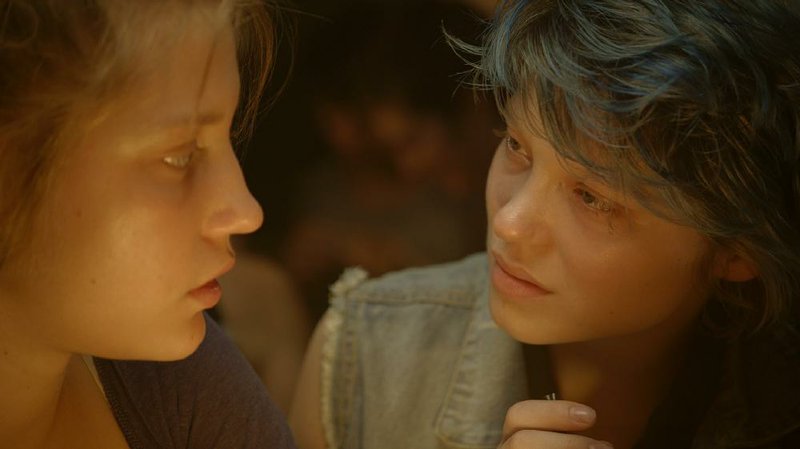One of the things I knew about Abdellatif Kechiche’s Blue Is the Warmest Color (this year’s Palm d’Or winner at Cannes) before I saw it was there are about 20 sexually explicit minutes in its practically three-hour run time. I don’t know whether that’s a particularly high ratio for films of this sort - by which I mean French lesbian coming-of-age dramas- but it says something that someone thought to put a stopwatch to it.
The second thing I knew was that it was based on an acclaimed French graphic novel by Julie Maroh (a book I acquired in translation a couple of months ago but refrained from reading until after I saw the film).
And the third, and what I thought most salient, thing I knew about the film was that there has been quite a bit of post-release drama: Lea Seydoux, who plays Emma, the blue-haired object of young Adele’s (Adele Exarchopoulos) affections, has alleged that Kechiche was quite the bully on the set. In response, Kechiche threatened to sue Seydoux for slander, and in response to that, the director’s crew released a statement condemning the director’s exploitative labor practices and general abuse of power. Both Seydoux and Exarchopoulos have said they have no intention of working with the director again, no many how many prizes accrue to them.
I couldn’t help but expect something more sensational than the wistful and tender film I received. While the simulated sex scenes (“love scenes” would be a more appropriate designation) are, in addition to being aesthetically beautiful in a classical sculptural sense (one allegedly took 10 days to film), possibly overlong and idealized, they are both gentler and no less grounded in reality than what we’d see in a conventional Hollywood drama. And, while they are a necessary component of the storytelling, they are hardly the point of the picture. (I will refrain from expressing too much dismay with the Motion Picture Association of America’s decision to saddle this film with an NC-17 rating - they probably had their own stopwatch out, as well as a checklist of naughty bits.)
While by no means un-erotic, Blue Is the Warmest Color isn’t a dirty movie. It is an imperfect and at times undisciplined study of how the heart wants what it wants and how love works its ways into ordinary lives. It is both beautiful and dull, but the dullness - the quotidian tempo of everydayness - provides a necessary contrast to the infatuating flood of feeling that overwhelms young working-class Adele who, at the beginning of the film, is a high school kid still fumbling through crushes. Things aren’t quite right with the cute boy (Jeremie Laheurte) she thinks she’d like to be with - they do the usual stuff but she’s indifferent to his attentions. When a girlfriend teases her, something perks up - and when the girl lets her down she’s more embarrassed than crushed.
Things begin to click into place when she exchanges glances with older, blue haired Emma, an out lesbian walking arm-in-arm with another woman in the street. A couple of cautious flirtations later, Emma and Adele find themselves rapturously entwined, and it’s not difficult to imagine that the younger woman believes she has found a place among Emma’s sophisticated, arty crowd.
Those initial fireworks naturally give way to a remarkably compelling (if less titillating) story of Adele’s sentimental education, taking her through her first real love and on to full-fledged adulthood and a kind of independence. (The French title of the film translates to The Life of Adele, Parts 1 and 2, which signals the director’s desire to distance his work from Maroh’s graphic novel - to which the film isn’t particularly faithful - and the possibility of a future for Adele.)
While neither of the lead actresses may care to work with the director again, neither has suggested that the result of their “exploitation” is a lousy movie. Blue Is the Warmest Color may not be to an individual moviegoer’s particular taste (though it will probably be a big date night movie for both heterosexual couples and same sex couples), it is an impressive, ambitious work that features a couple of remarkably naturalistic performances and demonstrates a genuine feel for how all of us, regardless of inclination, learn to live with love, or without it, in our own messy and overcomplicated human ways.
But if you’re just going to see French girls get naked, there are more efficient delivery systems.
Blue Is the Warmest Color 90
Cast: Lea Seydoux, Adele Exarchopoulos, Jeremie Laheurte, Salim Kechiouche Director: Abdellatif Kechiche Rating: NC-17, for explicit sexual content Running time: 179 minutes
MovieStyle, Pages 34 on 11/22/2013
